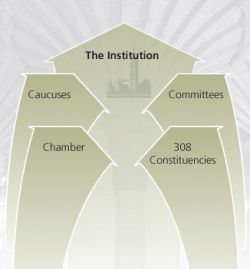Toronto Media Co-op
Local Independent News
Institutions build hierarchy between politico-cultural re-normalizations
In the steady state of a society, in the absence of large direct consequences of war at home, including civil war and class war, in the absence of believable threats of violence against the dominance hierarchy, there are viable institutions which all continuously and progressively act to strengthen the dominance hierarchy [a].
The institutions are meant to maintain order and to provide stability for and continuity of the dominance hierarchy; by eliminating, deflecting, and consuming all threats. This is done under the pretense of educating, protecting, and providing for the obedient subjects of the dominance hierarchy.
The professionals who run all institutions are embedded into the overarching societal dominance hierarchy and must serve this master in order to maintain their status and relative privileges. Despite the solemn institutional mission-statement verbiage, therefore, these professionals know -- for their own good -- who they really serve.
As a result, the institutions grow and develop policies, practices and structures that monotonously sharpen and perfect the hierarchical pyramid.
The illusory "foundational principles" of institutions are merely the comforting promises which deceive subjects into abandoning autonomy in favour of accepting paternalistic management, and hierarchical control.
In advancing hierarchy (corporate fascism) the institutions necessarily erode the appearance of their own needed illusory "foundational principles" and must hide this erosion with ever more complicated or obtuse verbiage and ever more detailed and convoluted policies and rules; in exercises of sophistry that equal the most awe-inspiring human achievements (e.g., read Supreme Court rulings and note what is not said).
The subjects must be "educated" to receive this sophistry as high expert knowledge, even as the "foundational principles" telescopically disappear in the face of reality.
In this way, the institutions (education, justice, health, finance, war, etc.) work together -- in a highly coordinated fashion -- to optimally support the dominance hierarchy. Jurisdictions are established, sequences of treatment enacted, etc.
The entire excise of law-making is an exercise in institution management and optimization to best serve and advantage the top strata of the dominance hierarchy.
And then, every once in a while, when circumstances in the bottom strata get too tense and the subjects start to see beyond the verbiage and expert management, things heat up and there may be adjustments, even re-normalizations, and we start somewhat refreshed, with clarified mission statements and so on.
And, following this jog or even back-step, "progress" can once again be pursued.
Such is the dance of institutional change as I see it.
The above theory of institutional change is predictive.
For example, since the institution's "foundational principles" pronouncements are a description of falsely promised repairs to damage necessarily caused by the dominance hierarchy and since the institution truly functions to support the dominance hierarchy, it follows that an institution will always work to distance itself from its own "foundational principles" and, where the stated "principles" give rise to strongly expressed expectations among the objectified subjects [1], to weaken ("re-define", "improve", "modernize", "clarify") its mission promises to the extent that it can.
The institution, therefore, works exactly to oppose its own "foundational principles" or purpose or mission statements because these statements are an expression of the targeted systemic consequences of hierarchy that the particular institution is meant to neutralize by subterfuge. The institution as substitute parent acknowledges the injustice, reassuringly states that the harm will be repaired via a fair (although complex) process, and sends the victim of hierarchy down a road with no issue; thereby cooling the mark out [2], causing the victim to invest in the false solution, and dissipating the complaint.
Another predicted consequence is that, for many individual professionals who work in institutions, there will be an unresolved dichotomy between elements of the individual's formal education regarding the benevolence of institutions and the dominant professional training culture of kissing ass to serve hierarchy and one's career "advancement." This, in turn, gives rise to the phenomenon of whistleblowers and their persecution and, depending on the degree of social integration of the professional culture, to the phenomenon of professional worker malaise [3]. Otherwise, cynicism and peer-group-identification are major outlets [3].
[This article was inspired by the incredible November 7, 2011, Final Order PO-3009-F of the Information and Privacy Commissioner, Ontario; that I plan to critique soon.]
Endnotes
[a] See this essay about the reality of the dominance hierarchy: Rancourt, Denis G. "Anti-smoking culture is harmful to health: On the truth problem of public health management." 2011.
[1] Freire, Paulo. "Pedagogy of the Oppressed." 1970.
[2] Goffman, Erving. “Cooling the Mark Out: Some Aspects of Adaptation to Failure.” Psychiatry Vol. XV: 451-63. 1952.
[3] Schmidt, Jeff. "Disciplined Minds: A critical look at salaried professionals and the soul-battering system that shapes their lives." 2000.
Other essays by Denis G. Rancourt
About the poster
Comments
Hair Transplant
Hair transplant at our center is done by a Plastic Surgeons who is member of the International Society of Hair Restoration Surgeons, ISHRS (USA). We practice Follicular Unit Micro grafting (FUT) which is the latest technique followed all over the world with consistent results. Hair Transplant Male and female patients who wish to undergo follicular unit micro grafting need not be completely bald. These micro grafts can be added in between the existing hair, without ant damage to the adjacent hair roots.
The site for the Toronto local of The Media Co-op has been archived and will no longer be updated. Please visit the main Media Co-op website to learn more about the organization.
